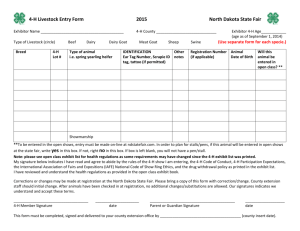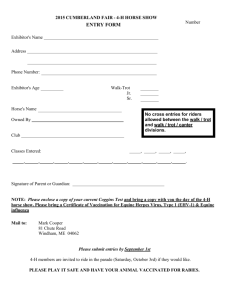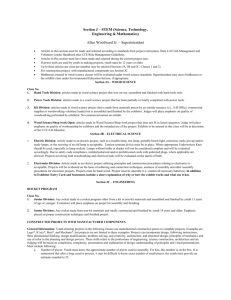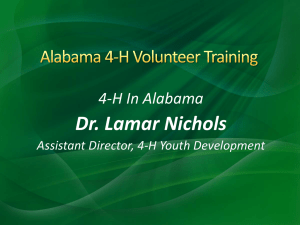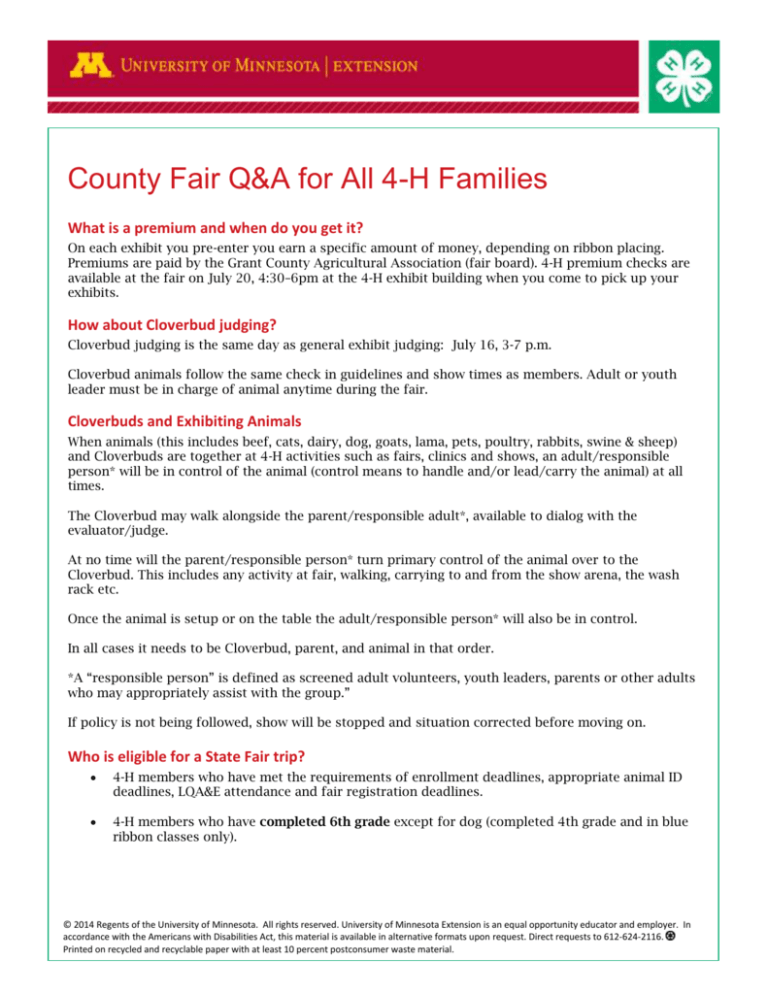
County Fair Q&A for All 4-H Families
What is a premium and when do you get it?
On each exhibit you pre-enter you earn a specific amount of money, depending on ribbon placing.
Premiums are paid by the Grant County Agricultural Association (fair board). 4-H premium checks are
available at the fair on July 20, 4:30–6pm at the 4-H exhibit building when you come to pick up your
exhibits.
How about Cloverbud judging?
Cloverbud judging is the same day as general exhibit judging: July 16, 3-7 p.m.
Cloverbud animals follow the same check in guidelines and show times as members. Adult or youth
leader must be in charge of animal anytime during the fair.
Cloverbuds and Exhibiting Animals
When animals (this includes beef, cats, dairy, dog, goats, lama, pets, poultry, rabbits, swine & sheep)
and Cloverbuds are together at 4-H activities such as fairs, clinics and shows, an adult/responsible
person* will be in control of the animal (control means to handle and/or lead/carry the animal) at all
times.
The Cloverbud may walk alongside the parent/responsible adult*, available to dialog with the
evaluator/judge.
At no time will the parent/responsible person* turn primary control of the animal over to the
Cloverbud. This includes any activity at fair, walking, carrying to and from the show arena, the wash
rack etc.
Once the animal is setup or on the table the adult/responsible person* will also be in control.
In all cases it needs to be Cloverbud, parent, and animal in that order.
*A “responsible person” is defined as screened adult volunteers, youth leaders, parents or other adults
who may appropriately assist with the group.”
If policy is not being followed, show will be stopped and situation corrected before moving on.
Who is eligible for a State Fair trip?
4-H members who have met the requirements of enrollment deadlines, appropriate animal ID
deadlines, LQA&E attendance and fair registration deadlines.
4-H members who have completed 6th grade except for dog (completed 4th grade and in blue
ribbon classes only).
© 2014 Regents of the University of Minnesota. All rights reserved. University of Minnesota Extension is an equal opportunity educator and employer. In
accordance with the Americans with Disabilities Act, this material is available in alternative formats upon request. Direct requests to 612-624-2116.
Printed on recycled and recyclable paper with at least 10 percent postconsumer waste material.
How do I win or take a State Fair trip?
When judging of a specific project area or animal show is completed the judge will make a state fair
lineup sheet.
There are predetermined quotas or number of youth who can go in any given project area.
Youth are limited to one animal science and one general exhibit along with a demonstration and/or
activity such as Share the Fun.
The state fair lineup will contain more names than the quota allows, accounting for youth who are too
young, or who choose to take a different opportunity or don’t wish to go.
The state fair lineup will be posted for all exhibits on a board in the 4-H exhibit building. It is your
responsibility if you are interested in a trip to let staff know to check the board.
It is the 4-H member’s responsibility to check that list if they are interested in a specific trip and to
accept or decline that trip by July 19, 4pm
Once you have accepted your trip and you are eligible in the quota system you may pick up your state
fair packet at the exhibit desk at the 4-H building. Please complete all paperwork and attend the state
fair meeting on July 20, 3:45pm right outside the 4-H Bldg.
Please bring cash or check to make payments at that meeting. All checks payable to the U of M.
If you have any questions about the state fair trip process please leave your question at the 4-H Bldg.
during the fair.
What is Vet Check?
All animals housed at the fair need to be examined by the fair veterinarian before unloading. You will
check in at the 4-H Bldg, tell what animals you are bringing to the fair, and pick up your stall cards and
exhibitor numbers; the vet will check your animals; and tell you if they are OK to pen.
Please be sure that you have followed all requirements for each bird and animal species: i.e. horses
need to have had Coggins check done and paperwork given to staff, etc.
Do I leave my animal or exhibit at the fair the whole time?
All animals except for pets, cats and dogs are to stay at the fair after they have been vet checked.
Animals are released beginning on July 20, 4:30pm.
What do I do when I come to get my building exhibits judged?
When you come to the fair with your building exhibits on July 16, come to the counter in the 4-H
building. Here we will go through your exhibit cards, and take out any that you will not be exhibiting.
Staff will put your name on the appropriate judge’s lists. Then take your exhibits to the appropriate
judging area, follow the signs for the appropriate areas and go back outside until staff calls your name
and exhibit area ready to be judged. If you have questions please ask at the counter.
What will the judge ask me?
The judge is excited to learn about your exhibit and wants to find out more about it. They will ask
questions like: Tell me about your exhibit? What did you learn by doing this exhibit? What might you
do differently? Did you share your exhibit with others? What didn’t work? What do you hope to
improve upon next year? They might also ask some basic questions like what did it cost, how do you
take care of it, where did you get your information? Make sure and thank the judge as well and Have
Fun!
What do I do with my project records?
Complete them and bring them with you to the county fair. The judge will ask you to see it; and will
keep them as part of your project report.
Most information is also contained in our Grant County Fair 4-H Premium booklet which will be
mailed to you in June. Please refer to it first because most questions will be answered there.
PRE-FAIR INFORMATION!
Parents Preparation and Expectations
How can I help my 4-Her?
One of the best places to start is by asking your children if they understand why they did the steps and
procedures they followed in their projects. Answer any questions they may have about their projects.
Then practice a conference judging experience with a parent playing the role of the judge.
On the day of conference judging, parents can help their children feel comfortable with the judge by
encouraging them prior to judging. Answering the judge’s questions for the children will not help your
children feel more comfortable or help them learn more about the project. This is the 4-Hers chance to
shine and be proud of their achievements. After judging, tell your children how proud you are of them.
Focus on “What did you learn?” rather than “What ribbon did you get?”.
Parent’s 4-H Pledge
I pledge my HEAD to give my child the information I can, to help him/her see things clearly and to
make wise decisions.
I pledge my HEART to encourage and support my child, no matter whether he/she has success or
disappointment.
I pledge my HANDS to help my child’s club or group; if I cannot be a leader, I can help in many equally
important ways.
I pledge my HEALTH to keep my child strong and well for a better world through 4-H, for our home,
my child’s club, our community, our country and our world.
What is 4-H Conference Judging?
4-H General Project Conference Judging:
Is a participatory process: a learner-centered conversation between a judge and the 4-Hers.
Enables the youth to demonstrate and gain knowledge from his/her project learning experience.
Provides an opportunity for the 4-Her to talk with a judge about his/her project learning for
evaluation process.
Conference judging of general exhibit projects is as important as the exhibit itself. The judge
determines a ribbon placing based on both the exhibit and on the project learning the 4-Her shares
during the interview. At this time the judge is able to observe, question, listen and challenge the 4-Her.
Equal importance is placed on the exhibit and on the interview; both components are worth 50%
toward the ribbon placing.
4-H Conference Judging:
Practice, Observe and Support: Help your child practice the judging experience. Judges have their
own style, but you can use the public presentation formula.
The child introduces themselves, they have a way of catching the judge’s attention immediately, they
take time to explain what they have done in the project and how the “thing” they have brought
represents their year in 4-H. Finally, they close by sharing one or two things which they will do
differently in the future.
Once your child has started the judging, step back and observe. Look for things which you can use to
praise your child. Do not become involved in the judging experience. When your child has finished, let
him or her know how proud you are.
Support the Judge: Our goal is to have a caring adult who wants to listen to kids first, an expert in the
project area is second. Sometimes the judge may not know everything that the member knows. That
is a good sign that your child has been learning a great deal.
There are no white, red, or blue ribbon kids. You can let your child know how much you value their
learning without knocking the judge. No matter what happens, your child will always be your Grand
Champion.
Find Time to Talk: The most important time for 4-H members at the County Fair is the time spent
after the conversation with the judge. Too many times we allow children and youth to leave the
experience without a chance to talk about it.
One of the most important roles of parents at County Fair is to help their children grow from the
experience.
After your child leaves the judging station, take some time to talk with them about how they feel, what
they have learned, how they might use the experience in other situations.
In ideal 4-H education, children have an experience, share the experience, reflect on it, apply it, and
generalize the learning to real life. The best a judge can do in 3-5 minutes is to see that the experience
is as positive as possible.
You can make time to continue the reflection, help them decide what it means and how they will use
the learning in the future.
Ribbon System
A modified Danish System is used for 4-H judging. Exhibits can earn a Blue, a Red or a White.
Blue Ribbon – indicates that in the judge’s opinion, the 4-Her shows above average workmanship,
knowledge and effort in the project based on the conference judging criteria.
Red Ribbon – indicates that in the judge’s opinion, the 4-Her shows expected or average workmanship,
knowledge and effort in the project based on the conference judging criteria.
White Ribbon – indicates that in the judge’s opinion, the 4-Her shows below average workmanship,
knowledge and effort in the project based on the conference judging criteria.
Grand Champion Ribbon – indicates the judge feels the exhibit is the very best within a specific
division.
Reserve Champion Ribbon – indicates the judge feels the exhibit is the second best within a specific
division.
Honorable Mention Ribbon – indicates the judge feels within the blue ribbon exhibits there are one or
more that are truly outstanding and merit special recognition.
Participation Ribbon – these ribbons are used in situations where competition is not emphasized. It
indicates the 4-H member has participated in the project or activity.
Cloverbud Ribbon – since Cloverbud exhibits are not judged on a competitive basis and exhibits are
not ranked in any order, all Cloverbuds receive the same ribbon.
Emphasis is placed on encouraging the child to share what they liked or learned about their
exhibit/work/activity and developing their self-esteem and confidence.
MAKE FAIR SAFE!
1. Do not allow your child to wear clothing with his/her name on it.
2. Encourage your child to always be with a buddy. For younger children (11 and under), this should
be an adult if possible.
3. Encourage your child to go directly from one place to another without making casual stops.
4. Plan a time when you can tour the fair with your child. When you do, enjoy the time together and
talk about what you find interesting. Try to do this early so that you can point out places where
helpful adults will be, as well as places where you would not want them to go without you.
5. Explain to your children that all kinds of people come to the fair. Most of these people are kind
and caring. They have come to the fair to have a good time. A few people may not behave as well.
If someone says or does anything that confuses or worries your child, they should go to a safe
adult immediately. It is not necessary to scare your child. Encourage them to rely on their
instincts.
6. Point out areas that are isolated or poorly lit. Suggest that children stay on well-lit paths and
places where large numbers of people can be found. Again, travel in groups.
7. If any child comes up to you and seems upset (including your own child), do not ask, “How can I
help you?” Remain calm.
Children need to know that adults are ready to help. Walk with the child to a place where help can
be provided. The 4-H Building and Fair Office are safe places.
8. No one knows your child as well as you. Use your best judgment to help your child have a safe and
enjoyable experience.
© 2014 Regents of the University of Minnesota. All rights reserved. University of Minnesota Extension is an equal opportunity educator and employer. In
accordance with the Americans with Disabilities Act, this material is available in alternative formats upon request. Direct requests to 612-624-2116.
Printed on recycled and recyclable paper with at least 10 percent postconsumer waste material.



